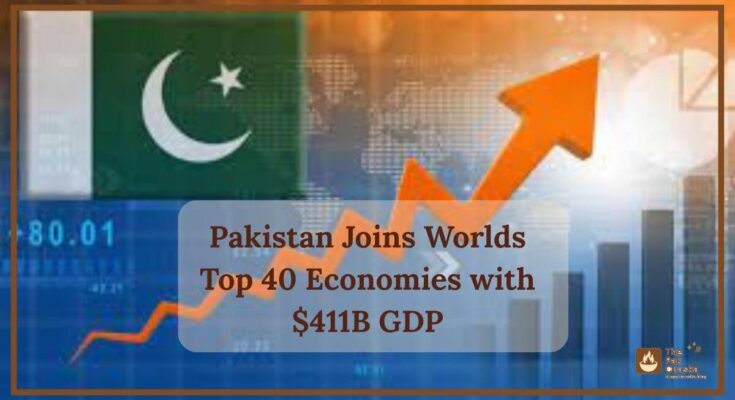Pakistan’s economy has officially joined the top 40 biggest economies in the world by nominal GDP for the first time in its history. This is a big step forward. Reports from Pakistan Strategic Forum and Abb Takk News say that the country’s GDP has reached $411 billion. This illustrates both the country’s economic potential and the role its large population played in achieving this success.
A Historic First for Pakistan’s Economy:
Pakistan has had a lot of problems with its economy, including unstable growth rates and problems with its foreign debt. This is the first time, though, that the country has been ranked among the top 40 economies in the world in terms of GDP. This indicates that Pakistan’s economy is still growing and has considerable untapped potential, despite facing political and financial challenges.
Even though GDP isn’t the only way to judge an economy’s strength, it is a big part of how investors, foreign organizations, and trade partners see a country. Pakistan’s $411 billion in output puts it on par with a number of mid-tier global economies. This shows that its input to the world economy is not small.
The Role of Population in Economic Growth:
Pakistan has a very large population—over 240 million people—which is a big reason for this achievement. Even though the country’s average income per person is still pretty low, its large population means that even moderate levels of output add up to a big economy.
This benefit in terms of population, which is often called the “youth bulge,” can be both good and bad. On the one hand, it gives Pakistan a huge pool of workers and customers. To fully use its promise, it also needs good governance, job creation, and management of its resources. If this group of people is used well, it could help Pakistan’s economy grow even more in the years to come.
Check Also: Nida Saleh Becomes Pakistans First Female Train Driver
Long-Term Projections: A Top 10 Economy by 2047?
Several economic predictions say that Pakistan’s place in the world economy could get a lot better over the next few decades. Analysts think that Pakistan could have one of the ten biggest economies by 2047 if it keeps up its reforms and policies that encourage growth. Some people think the prediction goes even further, saying that Pakistan might be in the top five by 2075.
Given Pakistan’s big domestic market, key trade routes passing through it, and ongoing investments in infrastructure and digital innovation, these predictions are not too far-fetched. To do this, though, big changes need to be made to government, industry, education, and the use of clean energy.
Challenges That Remain:
Pakistan is still having a hard time with its economy, even though it has made some progress. Households are still very worried about inflation, foreign reserves are under pressure from external debt, and political instability often makes it hard to plan for the long run. The country also has to deal with climate change risks, energy problems, and the need to update its farming industry.
Even though making it into the top 40 is a big deal, the government and lawmakers should see this as just the beginning and not the end. Pakistan needs to work on structural changes, better tax collection, and investments in human capital if it wants to go even higher.
Why This Milestone Matters:
The fact that Pakistan is now one of the world’s top 40 economies is good news for both investors and people. Although the economy has been unstable for years, this shows that the country’s foundations are still strong enough to support growth.
In addition, this accomplishment boosts Pakistan’s reputation in the world market. It could bring in more foreign direct investment (FDI) and make trade relationships stronger. This could lead to more work, higher incomes, and a higher standard of living for millions of Pakistanis if it is managed well.
Conclusion:
With a GDP of $411 billion, Pakistan has become one of the world’s top 40 largest economies. This is a proud time in those economies’ history. Even though raising the per capita income and reducing poverty are still problems, the country has a lot of room to grow in the future thanks to its large and strong economy.
Pakistan could be on its way to becoming one of the top 10 economies by 2047 and maybe even one of the top 5 economies by 2075 if the current trend continues and real changes are made. Nepal has a long way to go, but this important step shows that the country is on the right track.
